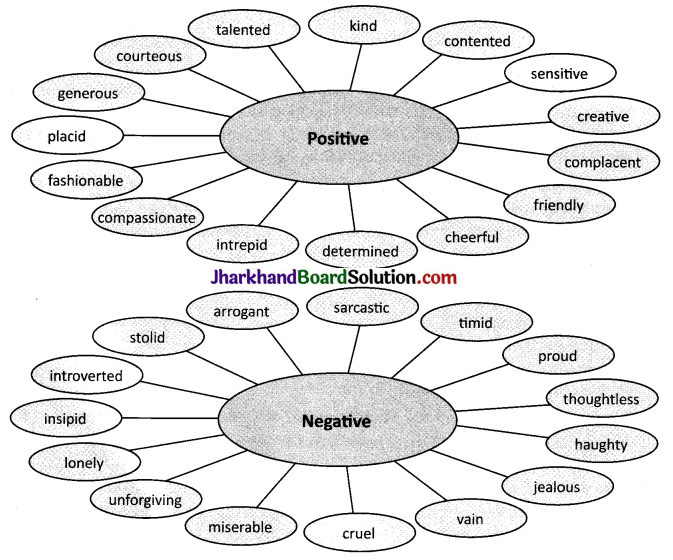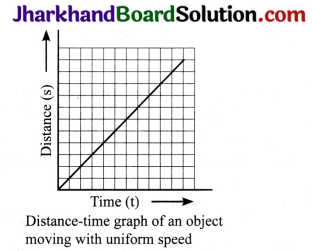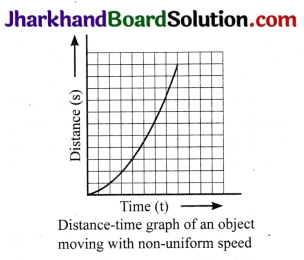JAC Board Class 10th English Solutions First Flight Chapter 4 From the Diary of Anne Frank
JAC Class 10th English From the Diary of Anne Frank Textbook Questions and Answers
Activity (Page – 49)
Question 1.
Do you keep a diary? Given below under ‘A’ are some terms we use to describe a written record of personal experience. Can you match them with their descriptions under ‘B’? (You may look up the terms in a dictionary if you wish.)
| (i) journal | A book with a separate space or page for each day, in which you write down your thoughts and feelings or what has happened on that day |
| (ii) Diary | A full record of a journey, a period of time, or an event, written every |
| (iii) log | A record of a person’s own life and experiences (usually, a famous person) day |
| (iv) Memoirs | A written record of events with times and dates, usually official |
Answer:
| (i) journal | A written record of events with times and dates, usually official |
| (ii) Diary | A book with a separate space or page for each day, in which you write down your thoughts and feelings or what has happened on that day |
| (iii) log | A full record of a journey, a period of time, or an event, written every |
| (iv) Memoirs | A record of a person’s own life and experiences (usually, a famous person) day |
Question 2.
Here are some entries from personal records. Use the definitions above to decide which of the entries might be from a diary, a journal, a log or a memoir.
(i) I woke up very late today and promptly got a scolding from Mum! I can’t help it – how can I miss the FIFA World Cup matches?
Answer:
Diary
(ii) 10 : 30 a.m. Went to the office of the Director 01 : 00p.m. Had lunch with Chairman 05 : 45 p.m. Received Rahul at the airport 09 : 30p.m. Dinner at home
Answer:
Log
(iii) The ride to Ooty was uneventful. We rested for a while every 50 km or so, and used the time to capture the magnificent landscape with my HandyCam. From Ooty we went on to Bangalore. What a contrast! The noise and pollution of this once-beautiful city really broke my heart.
Answer:
Journal
(iv) This is how Raj Kapoor found me all wet and ragged outside R. K. Studios. He was then looking for just someone like this for a small role in Mera Naam Joker, and he cast me on the spot. The rest, as they say, is history!
Answer:
Memoir
Oral Comprehension Check (Page – 51)
Question 1.
What makes writing in a diary a strange experience for Anne Frank?
Answer:
Writing in a diary was really a strange experience for Anne Frank. This was only because she had never written anything before. She also thought that nobody would be interested in the musings of a thirteen – year – old schoolgirl.
![]()
Question 2.
Why does Anne want to keep a diary?
Answer:
Anne wanted to keep a diary because she did not have a real friend. Although she had loving parents, a sixteen – year – old sister and about thirty people whom she could call her friends. She thought that paper had more patience than people. However, she did not have that one true friend. That is why she decided to keep a diary.
Question 3.
Why did Anne think she could confide more in her diary than in people?
Answer:
Anne did not have a true friend. Although she had many friends, but she only talked to them about day – to – day things. She did not seem to get any closer to them. She felt that maybe it was her fault that she could not confide in them. She knew that paper had more patience than people. So she decided to write and confide in a diary.
Oral Comprehension Check (Page – 51)
Question 1.
Why does Anne provide a brief sketch of her life?
Answer:
Anne provides a brief sketch of her life because no one would understand a word of her musings without knowing her whereabouts.
Question 2.
What tells you that Anne loved her grandmother?
Answer:
Anne’s grandmother had fallen seriously ill. Therefore, Anne’s birthday was not celebrated with much enthusiasm. Her grandmother died the next year. She missed her a lot. Anne wrote in her diary that no one knew how often she thought of her grandmother and still loved her.
Oral Comprehension Check (Page – 54)
Question 1.
Why was Mr Keesing annoyed with Anne? What did he ask her to do?
Answer:
Mr Keesing was annoyed with Anne because she talked too much in the class. He assigned her an extra homework and also asked her to write an essay on the subject, ‘A Chatterbox’.
Question 2.
How did Anne justify her being a chatterbox in her essay?
Answer:
In her essay, Anne wanted to come up with convincing arguments to prove the necessity of talking. She argued that talking was a student’s trait. She had inherited this trait from her mother. She would do her best to keep it under control. She further wrote that she would never be able to cure herself of this habit. This was how she justified her being a chatterbox in the essay.
![]()
Question 3.
Do you think Mr Keesing was a strict teacher?
Answer:
Mr Keesing was a strict teacher. He maintained discipline and silence in the class. He did not allow students to talk. He punished Anne by asking her to write an essay on ‘A Chatterbox However, when Anne continued with her talking, he punished her again by asking her to write another essay. This time the topic was ‘An Incorrigible Chatterbox ’. Even after this, when she continued talking, he asked her to write on the topic “Quack, Quack, Quack, Said Mistress Chatterbox”. He was trying to play a joke on her. However, she came up with a poem acknowledging its content. Therefore, Mr Keesing cannot be entirely called a strict teacher. He was fun – loving too.
Question 4.
What made Mr Keesing allow Anne to talk in the class?
Answer:
Anne was able to justify her talkative nature every time she was punished by Mr Keesing. As a punishment, the teacher gave her topics to write essays on three occasions. However, on each occasion, he was impressed by the manner in which she presented her arguments. Finally, Mr Keesing accepted the fact that Anne would always be that way. Hence, she was allowed to talk in the class.
Thinking about the Text
Question 1.
Was Anne right when she said that the world would not be interested in the musings of a thirteen-year – old girl?
Answer:
Anne was not absolutely right in her approach at this point. Her diary was published under the name ‘The Diary of a Young Girl’. In due course of time, it became one of the world’s most widely read books. It also gained more popularity.
Question 2.
There are some examples of diary or journal entries in the ‘Before You Read’ section. Compare these with what Anne writes in her diary. What language was the diary originally written in? In what way is Anne’s diary different?
Answer:
Anne’s diary was originally written in the Dutch language. Her diary is different from the others in many aspects. She thought her diary, Kitty, as her only true friend whom she could confide in. She wrote all her stories and day – to – day experiences in it. She started by writing ‘Dearest Kitty’ and ended the account by writing, ‘Yours, Anne’. It might be called a memoir.
Question 3.
Why does Anne need to give a brief sketch about her family? Does she treat ‘Kitty’ as an insider or an outsider?
Answer:
Anne gave a brief sketch about her family because no one would understand a word of her stories to her diary. She, therefore, wrote a brief sketch of her life, even though she disliked doing so. She treated ‘Kitty’ as an insider because she called it her best friend.
![]()
Question 4.
How does Anne feel about her father, her grandmother, Mrs. Kuperus and Mr Keesing? What do these tell you about her?
Answer:
Anne gave due respect to her father, grandmother, Mrs. Kuperus and Mr Keesing. She had much affection to her grandmother. She also remembered her after her death. She wrote in her diary that no one knew how often she thought of her grandmother and still loved her. While she was in her sixth standard at Montessori Nursery School, her teacher was Mrs. Kuperus, who was also the headmistress.
While giving heartbreaking farewell to Mrs. Kuperus, both were in tears. Mr Keesing was her Maths teacher. He was annoyed with her because she talked too much in the class. However, Anne justified her talkative nature every time she was punished by Mr Keesing. On each occasion, he was too much impressed by the manner in which she presented her arguments.
All these incidents show how lovable and smart Anne was. Everybody was attached to her.
Question 5.
What does Anne write in her first essay?
Answer:
In her first essay, titled ‘A Chatterbox’ Anne laid more emphasis on the trait of talking. She started thinking about the subject. She wrote three pages and was satisfied. She argued that talking was a student’s trait. She would not be able to control it because she had inherited this quality from her mother. It is beyond her capacity to overcome this problem. Mr Keesing too had a good laugh reading her arguments.
Question 6.
Anne says teachers are most unpredictable. Is Mr Keesing unpredictable? How?
Answer:
Anne felt that teachers are the most unpredictable creatures on the earth. Anne was very
talkative. The way Anne talked continuously while the class was in progress, any teacher would naturally lose his temper. However, after several warnings, Mr Keesing assigned her extra homework. She was told to write an essay on ‘A Chatterbox’.
In this manner, he tried to play a joke on her. While he asked her to write such essays, she wrote very well. She kept countering his jokes. One could not have predicted that he would take all the jokes in the right spirit. Ultimately, he accepted her talkative nature and also allowed her to talk in the class. In this way, it can be said that Mr Keesing was unpredictable.
Question 7.
What do these statements tell you about Anne Frank as a person?
1. We don’t seem to be able to get any closer, and that’s the problem. Maybe it’s my fault that we don’t confide in each other.
2. I don’t want to jot down the facts in this diary the way most people would, but I want the diary to be my friend.
3. Margot went to Holland in December, and I followed in February, when I was plunked down on the table as a birthday present for Margot.
4. If you ask me, there are so many dummies that about a quarter of the class should be kept back, but teachers are the most unpredictable creatures on earth.
5. Anyone could ramble on and leave big spaces between the words, but the trick was to come up with convincing arguments to prove the necessity of talking.
Answer:
- Anne had no true friend whom she could confide in. She even did not feel hesitation in taking fault on hers.
- Anne considered her diary as her true and trusted friend. She did not just want a diary in which she could write down the facts like other fellows.
- It shows her witticism and sense of humour.
- Teachers are the most unpredictable creature on the earth. Nobody could say which students they would fail and which students would be promoted to the next class.
- Anne knew a lot about writing. While she was given a topic for writing, she took it seriously and attempted with full vigour. She did not want to write like others who merely left big spaces between the words to make the essay look voluminous. Her trick was to come up with a convincing argument to prove the necessity of talking. She was different in her approach from everybody else.
Thinking about Language
I. Look at the following words. headmistress long – awaited homework notebook stilf – baeked outbursts These words are compound words. They are made up of two or more words.
Compound words can be:
- nouns: headmistress, homework, notebook, outbursts
- adjectives: long – awaited, stiff – backed
- verbs: sleep – walk, baby-sit
Match the compound words under ‘A’ with their meanings under ‘B’ Use each in a sentence.
| A | B |
| 1. Heartbreaking | – obeying and respecting the law |
| 2. Homesick | – think about pleasant things, forgetting about the present |
| 3. Blockhead | – something produced by a person, machine or organisation |
| 4. Law-abiding | – producing great sadness |
| 5. Overdo | – an occasion when vehicles/machines stop working |
| 6. Daydream | – an informal word which means a very stupid person |
| 7. Breakdown | – missing home and family very much |
| 8. Output | – do something to an excessive degree |
Answer:
| 1. Heartbreaking | – producing great sadness |
| 2. Homesick | – missing home and family very much |
| 3. Blockhead | – an informal word which means a very stupid person |
| 4. Law-abiding | – obeying and respecting the law |
| 5. Overdo | – do something to an excessive degree |
| 6. Daydream | – think about pleasant things, forgetting about the present |
| 7. Breakdown | – an occasion when vehicles/machines stop working |
II. Phrasal Verbs
A phrasal verb is a verb followed by a preposition or an adverb. Its meaning is often different from the meaning of its parts. Compare the meanings of the verbs get on and run away in (a) and (b) below. You can easily guess their meanings in (a) but in (b) they have special meanings.
(a)
- She got on at Agra when the bus stopped for breakfast.
- Dev Anand ran away from home when he was a teenager.
(b)
- She’s eager to get on in life, (succeed)
- The visitors ran away with the match, (won easily)
Some phrasal verbs have three parts: a verb followed by an adverb and a preposition.
(c) Our car ran out of petrol just outside the city limits.
(d) The government wants to reach out to the people with this new campaign.
Question 1.
The text you’ve just read has a number of phrasal verbs commonly used in English. Look up the following in a dictionary for their meanings (under the entry for the italicised word).
1. plunge (right) in
2. ramble on
3. kept back
4. get along with
Answer:
- plunge (right) in – dive into
- kept back – to not allow (someone) to go near something
- ramble on – talking for a long time in a boring way
- get along with – have a good understanding with others
Question 2.
Now find the sentences in the lesson that have the phrasal verbs given below. Match them with their meanings. (You have already found out the meanings of some of them.) Are their meanings the same as that of their parts?
(Note that two parts of a phrasal verb may occur separated in the text.)
(i) plunge in – speak or write without tõcus
(ii) kept back – stay indoors
(iii) move up – make (them) remain quiet
(iv) ramble on – have a good relationship with
(y) get along with – give an assignment (homework) to a person authority (the teacher)
(vi) calm down – compensate
(vii) stay in – go straight to the topic
(viii) make up for – go to the next grade
(ix) hand in – not promoted
Answer:
(i) plunge in – go straight to the topic Since no one would understand a word of my stories to Kitty if I were to plunge right in, I’d better provide a brief sketch of my life, much as I dislike doing so.
(ii) kept back – not promoted The reason, of course, is the forthcoming meeting in which the teachers decide who’ll move up to the next form and who’ll be kept back,
(iii) move up – go to the next grade The reason, of course, is the forthcoming meeting in which the teachers decide who’ll move up to the next form and who’ll be kept back,
(iv) ramble on – speak or write without focus Anyone could ramble on and leave big spaces between the words, but the trick was to come up with convincing arguments to prove the necessity of talking,
(v) get along with – have a good relationship with I get along pretty well with all my teachers,
(vi) calm down – make (them) remain quiet Even G.’s pleading glances and my angry outbursts can’t calm them down.
(vii) stay in – stay indoors I thought of this saying on one of those days when I was feeling a little depressed and was sitting at home with my chin in my hands, bored and listless, wondering whether to stay in or go out.
(viii) make up for – compensate This birthday celebration in 1942 was intended to make up for the other.
(ix) hand in – give an assignment (homework) to a person in authority (the teacher) I handed it in, and Mr Keesing had nothing to complain about for two whole lessons.
III. Idioms
Idioms are groups of words with a fixed order, and a particular meaning, different from the meanings of each of their words put together. (Phrasal verbs can also be idioms; they are said to be ‘idiomatic’ when their meaning is unpredictable.) For example, do you know what it means to ‘meet one’s match’ in English? It means to meet someone who is as good as
oneself, or even better, in some skill or quality. Do you know what it means to ‘let the cat out of the bag’? Can you guess?
Question 1.
Here are a few sentences from the text which have idiomatic expressions. Can you say what each means? (You might want to consult a dictionary first.)
1. Our entire class is quaking in its boots………………..
2. Until then, we keep telling each other not to lose heart ……………..
3. Mr Keesing was annoyed with me for ages because I talked so much ………………
4. Mr Keesing was trying to play a joke on me with this ridiculous subject, but I’d make sure the joke was on him………………
Answer:
- Shaking with fear and nervousness
- Not to lose hope
- For a long time
- He was outwitted by her.
Question 2.
Here are a few more idiomatic expressions that occur in the text. Try to use them in sentences of your own.
1. caught my eye
2. he’d had enough
3. laugh ourselves silly
4. can’t bring myself to
Answer:
- caught my eye: The beautiful diamond necklace in the shop caught my eye.
- he’d had enough: He’d had enough of the bullying that he faced everyday.
- laugh ourselves silly: John and I laugh ourselves silly at the new cartoon show.
- can’t bring myself to: I can’t bring myself to eat anything but sweets.
IV. Do you know how to use a dictionary to find out the meanings of idiomatic expressions? Take, for example, the expression caught my eye in the story. Where under which word would you look for it in the dictionary? Look for it under the first word. But if the first word is a ‘grammatical’ word like a, the, for, etc., then take the next word. That is, look for the first ‘meaningful’ word in the expression. In our example, it is the word caught.
But you won’t find caught in the dictionary, because it is the past tense of catch. You’ll find caught listed under catch. So you must look under catch for the expression caught my eye. Which other expressions with catch are listed in your dictionary? Note that a dictionary entry usually first gives the meanings of the word itself, and then gives a list of idiomatic expressions using that word. For example, study this partial entry for the noun ‘eye’ from the Oxford Advanced Learner’s Dictionary, 2005.
Eye
- Noun
- Part of Body 1 [C] either of the two organs on the face that you see with: The suspect has
dark hair and green eyes. - Ability to See 3 [sing.] the ability to see: A surgeon needs a good eve anda steady hand.
- Way of Seeing 4 [C] usually sing a particular way of seeing sth: He looked at the design
with the eve of an engineer - Of Needle 5 [C] the hole in the end of a needle that you put the thread through.
IDM be all eyes to be watching sb/sth carefully and with a lot of interest before/in front of sb’s (veiy) eyes in sb’s presence; in front of sb: He had seen his life work destroyed before his very eyes. Be up to your eyes In sth to have a lot of sth to deal with: We ‘re up to our eyes in work.
You have read the expression ‘not to lose heart’ in this text. Now find out the meanings of the following expressions using the word ‘heart’. Use each of them in a sentence of your own.
1. break somebody’s heart
2. close/dear to heart
3. from the (bottom of your) heart
4. have a heart
5. have a heart of stone
6. your heart goes out to somebody
Answer:
- break somebody’s heart – to upset somebody deeply It has unfortunately become very easy these days to break somebody’s heart.
- close/dear to heart – something or someone who is near and close The drawing given to me by my little daughter is very close to my heart.
- from the (bottom of your) heart – sincere and deep feeling He loved his son from the bottom of his heart.
- have a heart – to show pity The poor beggar asked the rich man to have a heart and give him something to eat.
- have a heart of stone – cruel nature The landlady has a heart of stone as she beats up her children.
- your heart goes out to somebody – to sympathise with someone My heart goes out to the little girl who lost both her parents in a car accident.
V. Contracted Forms
When we speak, we use ‘contracted forms’ or short forms such as these: can’t (for can not or cannot) I’d (for I would or I had) she’s (for she is) Notice that contracted forms are also written with an apostrophe to show a shortening of the spelling of not, would, or is as in the above example. Writing a diary is like speaking to oneself. Plays (and often, novels) also have speech in written form. So we usually come across contracted forms in diaries, plays and novels.
Question 1.
Make a list of the contracted forms in the text. Rewrite them as full forms of two words.
For example:
I’ve = I have
(i) I’ve = I have
(ii) Doesn’t = does not
(iii) Won’t = would not
(iv) I’m =Iam
(v) Don’t =donot
(vi) Can’t = cannot
(vii) it’s = it is
(viii) That’s = that is
(ix) I’d = I would
(x) Didn’t = did not
(xi) Who’ll = who will
(xii)You’re = You are
(xiii) We’ll = We will
(xiv)There’s = there is
(xv) He’d = he had
(xvi) Who’s = who is
(xvii) Haven ‘t = have not
Question 2.
We have seen that some contracted forms can stand for two different full forms:
I’d = I had or I would
Find in the text the contracted forms that stand for two different full forms, and say what these are.
Answer:
(i) I’d = I had or I would
(ii) He’d = He had or he would
Speaking
Here is an extract adapted from a one-act play. In this extract, angry neighbours Who think Joe the Inventor’s new spinning machine will make them lose their jobs come Joe’s model of the machine. You’ve just seen how contracted forms can make a written text sound like actual speech. try to make this extract sound more like a real conversation by changing some of the verbs
into contracted forms. Then speak out the lines.
[The door is flung open, and several men tramp in. They carry sticks, and one of them, HOB, has a hammer]
HOB : Now where is your husband, mistress’?
MARY : In his bed. He is sick, and weary. You would not harm him!
HOB : We are going to smash his evil work to pieces. Where is the machine?
SECOND MAN : On the table yonder.
HOB : Then here is the end of it! [HOB smashes the model. MARY screams.]
HOB : And now for your husband!
MARY : Neighbours, he is a sick man and almost a cripple. You would not hur
HOB : He is planning to take away our daily bread… We will show him what of him and his ways!
Answer:
MARY : You have broken his machine… You have done enough
HOB : Now where’s your husband, mistress’?
MARY : In his bed. He’s sick, and weary. You won’t harm him!
HOB : We’re going to smash his evil work to pieces. Where’s the machine?
SECOND MAN : On the table yonder.
HOB : Then here’s the end of it; [HOB smashes the model. MARY screams.]
HOB : And now for your husband!
MARY : Neighbours, he’s a sick man and almost a cripple. You won’t hurt him!
HOB : He’s planning to take away our daily bread.., we’ll show him what we think of him and his ways!
MARY : You’ve broken his machine… You’ve done enough…
Writing
Now you know what a diary is and how to keep one. Can you keep a diary for a week recording the events that occur? You may share your diary with your class, if you wish to. Use the following hints to write your diary.
- Though your diary is very private, write as if you are writing for someone else.
- Present your thoughts in a convincing manner.
- Use words that convey your feelings, and words that ‘paint pictures’ for the reader. Be brief.
‘Diary language’ has some typical features such as subjectless sentences (Got up late in the morning), sentence fragments without subjects or verbs (…too bad, boring, not good), contracted forms (they’re, I’ve, can’t, didn’t, etc.), and everyday expressions which people use in speech. Remember not to use such language in more formal kinds of writing.
Answer:
Do it yourself.
Listening
Your teacher will read out an extract from The Diary of Samuel Pepys (given on the next page) about the great fire of London. As you listen complete this summary of the happenings.
Answer:
Summary
This entry in the diary has been made on 2nd September by Samuel Pepys. The person who told Pepys about the fire was called Jane. She called at three in the morning. Pepys went back to sleep because the fire was on the backside of the Marke – Lane. Pepys rose again at seven in the morning. By then about three hundred houses had been burned down. The fire had spread to Fish street by London Bridge. Pepys then walked to the Tower along with Sir J. Robinson’s little son.
JAC Class 10th English From the Diary of Anne Frank Important Questions and Answers
I. Short Answer Type Questions (20 – 30 words & 2 marks each)
Question 1.
How was Mr Keesing a kind but strict teacher?
Answer:
Mr Keesing was a kind but strict teacher. He was annoyed with Anne as she used to talk a lot. He had warned her many times but she refused to comply. Hence, he punished her by giving her an essay to write.
Question 2.
Where did Anne live after her parents had left for Holland?
Answer:
After Anne’s parents had migrated to Holland, she lived with her grandmother for some months.
Question 3.
Why was Anne in tears when she left the Montessori school?
Answer:
In her sixth form in Montessori school, Mrs Kiiperus was the headmistress. Anne loved her profoundly. Mrs Kuperus also showed great affection towards Anne. That’s why she was in tears while leaving the Montessori school.
![]()
Question 4.
‘Grandma had a significant place in Anne’s heart’. Explain.
Answer:
Anne loved her grandma very much. She died in January 1942. Her death was all the more troublesome to Anne. Grandma played a significant role in shaping the life of Anne Frank. At Anne’s birthday, a separate candle was lit for grandma.
Question 5.
Why were the classmates of Anne Frank shaking with fear and nervousness?
Answer:
The classmates of Anne Frank were shaking with fear and nervousness because it was time to move to the next class. The students were quite ignorant who would be kept back and who would be promoted.
Question 6.
What did Anne write in her first essay?
Answer:
Anne wrote that talking is a student’s trait. So, she would not stop talking because her mother talked a lot. She had inherited this trait from her mother.
Question 7.
How did Sanne help Anne Frank in writing the third essay?
Answer:
Sanne was one of Anne Frank’s friends. She suggested Anne to write the essay in verse form. She also advised her to put up the example of a duck and a swan and their ducklings in it.
II. Short Answer Type Questions (40 – 50 words & 3 marks each)
Question 1.
How did Anne feel about her father, grandmother, Mrs Kuperus and Mr Keesing?
Answer:
Anne loved her father very much. He was adorable to her. She also loved her grandmother
and often remembered her with reverence after her death. She was deeply attached to her teacher, Mrs Kuperus and was in tears when she left her. Anne did not have a good impression of Mr Keesing, her maths teacher and often called him ‘old fogey’.
Question 2.
In what manner did Anne want her diary to be different?
Answer:
Anne did not want to follow the conventional use of a diary like people jotting down the facts in their diaries. She wished the diary to be her friend. She called it a Kitty. She would write about her feelings and experiences in it. It was a mature piece of work, reflecting profound insight.
Question 3.
‘Teachers are the most unpredictable creature on the earth’. What does it mean?
Answer:
Anne and her classmates thought that teachers were the most unpredictable creature the on
earth as it was hard to know or even guess what was going in their minds and what kind of step they would take regarding something.
Question 4.
Why did Anne feel alone?
Answer:
Anne had loving parents, her sixteen-year-old sister and around thirty-people whom she could call her friends. She had a loving aunt, family and a good home. Notwithstanding, she felt kind of hollow deep inside as she did not have a friend to whom she could confide herself. And she found such friend in the form of a diary.
![]()
Question 5.
Why did Anne Frank feel suffocated?
Answer:
Anne Frank was a very sensitive girl. She was cut off from the mainstream of life, her friends and her people. She was living in a hiding to escape being arrested by the Nazis. Moreover, she could not share her intimate and personal feelings with so-called friends. In this way, she felt suffocated. And to cope up with this, she resolved to write in a diary. She had named her diary ‘Kitty’.
Question 6.
‘Paper has more patience than people’. Elucidate this on the basis of the lesson.
Answer:
People are not always interested in listening to what you tell them. They get bored, feel monotonous and lose patience. But this does not happen with paper. You can write whatever you like and how long as you like. Sometimes people do not want to share their personal feelings with anyone. They just jot down their feelings on paper. That is why Anne also kept her feelings on pages and told that paper has more patience than people.
Question 7.
Who taught Anne Frank maths? Why did the maths teacher always get annoyed with her?
Answer:
Mr Keesing taught her maths. He always got annoyed with her because she talked too much in the class. To stop this practice, he also gave her to write an essay on ‘An Incorrigible Chatterbox’ as punishment. Even then she did not stop talking. That is why Mr Keesing always got irritated.
Question 8.
Why was the whole class quacking in boots?
Answer:
There was much tension in the class. All the students were waiting for the examination results and the teachers were busy in preparing their results. Students were quite apprehensive about their result. That is why the whole class was quacking in boots.
III. Long Answer Type Questions (100 – 120 words & 5 marks each)
Question 1.
Give an account of Anne’s life.
Answer:
Anne Frank lived with her parents in Germany. She was a Jewish girl. Hitler’s Nazi party was against the Jews. The Nazis used to either kill them or force them to work in the concentration camps. The Frank family emigrated from Germany in 1933 and took shelter in the Netherlands. But, Germany attacked Netherlands and captured it in 1940. Then the Nazis started to arrest the Jews and send them to concentration camps.
To avoid the Nazis, Frank family went into a hiding secretly. They hid there for twenty – five months. Anne had started writing diary before going to hiding. Eater they were arrested and sent to the concentration camps. Soon, Anne, her sister Margot and her mother died there. Her father survived and published a part of Anne’s diary. In this diary, Anne had given a moving and tragic account of the difficulties faced by her family and the other Jews.
Question 2.
Was Anne Frank far more intelligent, mature and witty than her age? Explain.
Answer:
Anne Frank was far more intelligent, mature and witty than her age. She started writing diary when she was thirteen. She also knew that not many people would be interested in her musings. Being a sensitive girl, she knew the difference between a true friend and so – called crowd of friends. Her diary was not about facts and figures, instead she opened out her suppressed self. Being an intelligent girl, she knew that paper has more patience than people.
Being aware of the difference between true friend and crowd of friends, she confided herself in ‘Kitty’, her diary. She considered it her true friend. Anne knew how to defeat people in their own games. This is evident from the argument she gave in support of talking in her first essay. Mr Keesing’s prank on Anne to write an essay on a ridiculous subject was reciprocated well by her. He acknowledged the message of Anne in the right spirit and her writing changed him. Mr Keesing then allowed her to talk and didn’t give her extra work anymore.
Question 3.
Why did Anne Frank think that she could confide more in her diary than in the people?
Answer:
Anne felt alone, bored and depressed. Although she had loving parents, a sister and thirty ‘ other people with whom she could share her feelings. She was a shy, introvert type of girl. She did not have any friend. She had a happy family but somehow, she could not confide in them. She wanted someone with whom she could share her secrets. She found a real friend ‘ in her diary ‘Kitty’. Moreover, she realized the truth lying in the fact that paper had more patience than people. So, she could confide more ideas in her diary than in people because people were not always interested in listening to us.
![]()
Question 4.
How did Anne respond to the punishment by Mr Keesing? What light does it throw on her nature?
Answer:
Anne Frank was of talkative nature. When Mr Keesing punished Anne for her talkativeness again and again and asked her to write essay, one after the other, she composed a poem on ‘The Incorrigible Chatterbox’ and gave a message through it to the teacher. The teacher was so impressed by her little poem that he decided not to punish her again. It shows that she was capable of writing good essays and poems and to win the heart of Mr Keesing and make him realize his mistake. It also reflects her fearlessness, critical thinking, unbiased approach as well as her creativity and humorous approach to deal with her strict teacher.
Question 5.
“No one will take interest in the musings of a thirteen-year-old child”. Is it right? Elaborate this statement in the light of Anne’s Diary and also write the values related with it.
Answer:
According to Anne, it is the common perception of people that the elders do not take much interest in the thought or musings of youngsters. People think that the teenagers are hardly mature. They have little exposure to the practical aspects of the world. Teenagers are taken seriously because of their wisdom and practical knowledge or if they are prodigy. When we see it in the light of Anne’s opinion and her life we find that the perception and her statement do not hold true.
Though Anne had not been taken seriously by any grown ups including her parents during their stay in the Secret Annexe yet, we cannot doubt her maturity and intelligence when we read her diary. She kept on writing in her diary in the beginning. Later, with the passage of time, her views were accepted by elders, particularly by her father. Hence, we can say that Anne might have her own experience while saying about this but the whole world has appreciated the musings of the same girl, Anne Frank.
Question 6.
“Writing in a diary is a really strange experience for someone like me. Not only because I’ve never written anything before, but also because it seems to me that later on neither I nor anyone will be interested in the musings of a thirteen-year old school girl.”
On the basis of the passage given above write why the author gives so much importance to diary.
Answer:
In diary, one writes down one’s thoughts and feelings. He/She jots down his/her day – to – day activities in diary. It is really the remembrance of one’s life long journey. A person grows old with the passing of each year and when he takes a glance at his past journey, at that moment a diary plays an important role. It makes him aware about his past life. So far the importance of dairy in the case of Anne Frank is concerned, it really played a significant role in her life. Since her childhood, she developed the habit of diary writing. It was really a strange experience for her.
This thing was always prevalent in her mind that if she spoke to anybody about anything, nobody would take interest in it. Either people will not agree with his views or they will ignore it. She will have to convince all the people. Even if a thirteen – year old girl says something, no body will take interest in her musings. So, diary is the best way or medium to jot down one’s thoughts, memories, experiences, etc. It is such a thing through which everybody can be convinced. That is why the author gives so much importance to diary. It makes not only the narrator but also the reader convinced about one’s happenings in life.
![]()
Question 7.
Yes, paper does have more patience and since I’m not planning to let anyone else read this stiff – backed notebook grandly referred to as a ‘diary’, unless I should ever find a real friend, it probably won’t make a bit of difference. Why does the author give much importance to paper than a friend? Discuss.
Answer:
According to Anne Frank, paper has more patience than people. She was adamant on this view. She really found a real friend in the form of dairy whose name was ‘kitty’. She gave it more importance than to any of her friends. She considered it her real friend with whom she could talk to, share her feelings, happiness, misery, and all the day to day activities pertaining to her life. In it, she could jot down her feelings with pen and pencil. Anne also did not have a true friend. Although she had many friends, she only talked to them about day – to – day things, she was not closer to them.
It might be her fault that she could not confide in them. She knew that paper had more patience than people. So, she decided to write and confide in a diary. Because people are not always interested in listening to what you tell them. They get bored, feel monotonous and lose patience. But this does not happen with paper. Sometimes people do not want to share their personal feelings with anyone. They just jot down their feelings on paper. That is why Anne kept her feelings on paper as it has more patience than people.
Reference To Context
Read the extracts given below and answer the questions that follow:
Question 1.
WRITING in a diary is a really strange experience for someone like me. Not only because I’ve never written anything before, but also because it seems to me that later on neither I nor anyone else will be interested in the musings of a thirteen – year – old schoolgirl. Oh well, it doesn’t matter. I feel like writing, and I have an even greater need to get all kinds of things off my chest.
Choose the correct option:
(a) What is really a strange experience for Anne?
(i) Reading a novel
(ii) Writing in a diary
(iii) Work on project
(iv) Gossipping with friends
Answer:
(ii) Writing in a diary
(b) What is the age of the girl?
(i) Twelve – year – old
(ii) Ten – year – old
(iii) Thirteen – year – old
(iv) Fourteen – year – old
Answer:
(iii) Thirteen – year – old
(c) Nobody will be interested in the girl.
(i) alertness
(ii) musings
(iii) naughtiness
(iv) both (i) and (ii)
Answer:
(ii) musings
(d) Did the narrator write anything before?
(i) No
(ii) Yes
(iii) Perhaps
(iv) All of these
Answer:
(i) No
(e) Find out a word from the passage similar in meaning to ‘thought.’
(i) fallacy
(ii) thoughtless
(iii) musings
(iv) attentive
Answer:
(iii) musings
![]()
Question 2.
‘Paper has more patience than people.’ I thought of this saying on one of those days when I was feeling a little depressed and was sitting at home with my chin in my hands, bored and listless, wondering whether to stay in or go out. I finally stayed where 1 was, brooding Yes, paper does have more patience, and since I’m not planning to let anyone else read this stiff – backed notebook grandly referred to as a ‘diary’, unless I should ever find a real friend, it probably won’t make a bit of difference.
Choose the correct option:
(a) What has more patience than people?
(i) Writing
(ii) Reading
(iii) Paper
(iv) Pen
Answer:
(iii) Paper
(b) Who was feeling a little depressed?
(i) Anne
(ii) Margo
(iii) Anne’s father
(iv) Anne’s mother
Answer:
(i) Anne
(e) Anne finally stayed where she was .
(i) talking
(ii) brooding
(iii) writing
(iv) walking
Answer:
(ii) brooding
(d) The stiff – backed notebook has been referred to as a
(i) Log
(ii) Diary
(iii) Memoir
(iv) None of these
Answer:
(ii) Diary
(e) Find out a word from the passage similar in meaning to ‘unenthusiastic.’
(i) listless
(ii) enthusiastic
(iii) powerful
(iv) anxious
Answer:
(i) listless
Question 3.
I have loving parents and a sixteen-year-old sister, and there are about thirty people I can call friends. I have a family, loving aunts and a good home. No, on the surface I seem to have everything, except my one true friend. All I think about when I’m with friends is having a good time. I can’t bring myself to talk about anything but ordinary everyday things. We don’t seem to be able to get any closer, and that’s the problem. Maybe it’s my fault that we don’t confide in each other. In any case, that’s just how things are, and unfortunately they’re not liable to change. This is why I’ve started the diary.
Choose the correct option:
(a) Whom did Anne call her friends?
(i) Her parents
(ii) Sixteen – year old sister
(iii) About thirty people
(iv) All of these
Answer:
(iv) All of these
(b) What did Anne find on the surface?
(i) Anne found everything on the surface.
(ii) Anne did not find anything on the surface.
(iii) Anne found everything on the surface except her true friend.
(iv) All of these
Answer:
(iii) Anne found everything on the surface except her true friend.
(c) Anne can’t bring herself to talk about anything but ………… everyday things.
(i) extraordinary
(ii) unique
(iii) ordinary
(iv) none of these
Answer:
(iii) ordinary
(d) What was the good time for her?
(i) When she was busy in gossiping.
(ii) When she was busy in cooking.
(iii) When she was busy in painting.
(iv) When she was with her friends.
Answer:
(iv) When she was with her friends.
(e) Find out a word from the passage similar in meaning to ‘reveal’.
(i) hide
(ii) confide
(iii) liable
(iv) change
Answer:
(ii) confide
![]()
Question 4.
That evening, after I’d finished the rest of my homework, the note about the essay caught my eye. I began thinking about the subject while chewing the tip of my fountain pen. Anyone could ramble on and leave big spaces between the words, but the trick was to come up with convincing arguments to prove the necessity of talking. I thought and thought, and suddenly I had an idea. I wrote the three pages Mr Keesing had assigned me and was satisfied. I argued that talking is a student’s trait and that I would do my best to keep it under control, but that I would never be able to cure myself of the habit since my mother talked as much as I did if not more, and that there’s not much you can do about inherited traits.
Choose the correct option:
(a) What had Anne finished that evening?
(i) The rest of her homework
(ii) The rest of her household chores
(iii) The rest of her painting
(iv) She did not finish anything
Answer:
(i) The rest of her homework
(b) About whom did Anne think while chewing the tip of her fountain pen?
(i) About morning breakfast
(ii) About her friends
(iii) About the subject of the essay
(iv) About playing games
Answer:
(iii) About the subject of the essay
(c) Anne argued that …………… is a student’s trait.
(i) talking
(ii) walking
(iii) writing
(iv) running
Answer:
(i) talking
(d) What did Anne want to prove?
(i) Anne wanted to prove her talent.
(ii) Anne wanted to prove the necessity of talking.
(iii) Anne wanted to prove her credentials.
(iv) All of these
Answer:
(ii) Anne wanted to prove the necessity of talking.
(e) Find out a word from the passage similar in meaning to ‘logic’.
(i) argument
(ii) philosophy
(iii) ramble
(iv) wit
Answer:
(i) argument
![]()
Question 5.
Mr Keesing had a good laugh at my arguments, but when I proceeded to talk my way through the next lesson, he assigned me a second essay. This time it was supposed to be on ‘An Incorrigible Chatterbox. ’ I handed it in, and Mr Keesing had nothing to complain about for two whole lessons. However, during the third lesson he’d finally had enough. “Anne Frank, as punishment for talking in class, write an essay entitled ‘Quack, Quack, Quack, Said Mistress Chatterbox’.”
Choose the correct option:
(a) Who made a good laugh at Anne’s arguments?
(i) Mr Keesing
(ii) Sanne
(iii) Margot
(iv) None of these
Answer:
(i) Mr Keesing
(b) What did Mr Keesing assign to Anne?
(i) To write a poem
(ii) To write the second essay
(iii) To solve the maths problem
(iv) None of these
Answer:
(ii) To write the second essay
(c) Anne was given to write an essay as punishment on the topic in the class.
(i) A Chatterbox
(ii) An Incorrigible Chatterbox
(iii) Quack, Quack, Quack, Said Mistress Chatterbox
(iv) None of these
Answer:
(iii) Quack, Quack, Quack, Said Mistress Chatterbox
(d) For how many lessons did Keesing not complain?
(i) One lesson
(ii) Two lessons
(iii) Three lessons
(iv) None of these
Answer:
(ii) Two lessons
(e) Find out a word from the passage similar in meaning to ‘logic.’
(i) arguments
(ii) reason
(iii) admiration
(iv) pretension
Answer:
(i) arguments
From the Diary of Anne Frank Summary
From the Diary of Anne Frank About the Author
- Anne Frank was bom on 12 June, 1929 in Frankfurt, Germany.
She was a German bom diarist. - Otto Frank and Edith Frank were her father and mother respectively.
Margot Frank was her sister. - She moved to Aachen with her elder sister at the age of four and half to stay with their grandmother when the Nazis gained control over Germany.
- She lost her German citizenship in 1941 and became stateless.
- She got acclaim and popularity with the publication of “The Diary of a Young Girl’’ in which she narrated about her life in hiding from 1942 to 1944.
- She died in February 1945.
From the Diary of Anne Frank Gist of the Lesson
This is the story of a young girl, Anne Frank. Anne Frank wrote her diary in hiding with her family. The diary was written at the ime of World War II. It was really a unique experience for her while writing a diary. In the initial stage while she started writing diary, she was quite depressed and , dej ected. She was thinking about her family, parents and sister. In spite of all these, she wanted a true friend which she found in the form of a diary. There were thirty people around her whom she could consider as friends. In 1933, her parents went to Holland.
She only stayed with their grandmother at Aachen. Anne was sent to Montessori School where she studied till six years of her age. While she was in sixth standard, the examinations were held. On the day of declaration of result, the entire class was in tense mood and all students were nervous. Mr Keesing was her maths teacher. Anne was very talkative. As a punishment, the teacher gave her to write a topic on “A Chatterbox” which she could not write properly. She thought that talking was a student’s trait. Seeing this, Mr Keesing laughed loudly.
Now he gave another topic to her to write on, i.e., “An Incorrigible Chatterbox”. For the third time, she was given a topic “Question uack, Question uack, Question uack”, said Mistress Chatterbox. At this topic, not only Anne but also the entire class laughed loudly. Now with the help of her friend Sanne, she wrote in verse. The poem was about a mother duck, father swan along with three baby ducklings. The baby ducklings quacked too much so the father swan took them to death. It was a joke on Mr Keesing’s part. Thus, the story provides a vivid description of day – to – day life under Nazi occupation. Most importantly, it depicts the truth as described by Anne Frank – ‘Paper has more patience than people’.
From the Diary of Anne Frank Summary
1. Diary writing-a strange experience: Diary writing is really a strange experience for the author. It was her perception that nobody would take interest in the musings of a thirteen – year – old school girl. But it hardly matters. Apart from all these things, she jotted down all her personal experiences in a diary.
2. Family details of Anne: Anne had loving parents and a sixteen-year-old sister. She made diary her personal friend and named it ‘Kitty’. Her father was most adorable. Her sister, Margot was bom in Frankfurt (Germany) in 1926. Anne was bom on 12 June 1929. Her father emigrated to Holland in 1933 along with mother. Anne’s grandmother took her care at Aachen. Her grandmother died in January 1942.
3. Anne’s education: She was admitted to Montessori nursery school and stayed there until six. Mrs Kuperus was her headmistress at the school.
4. The atmosphere of class: There was the atmosphere of fear and nervousness in the class. All the students were in fear whether they would move to the next class or would remain in the same. Each one was guessing about each other. They were in the apprehension that about a quarter of the class should be kept back. But teachers are the most unpredictable creature on the earth.
5. Punished by the teacher: Mr Keesing, the maths teacher was annoyed with Anne because she talked too much in the class. Getting irritated from her, he assigned her extra work. And she was told to write an essay on the subject, ‘A Chatterbox’. After thinking a lot about the topic, convincing thoughts came into her mind. She argued that talking is a student’s trait and she would do her best to keep it under control.
6. Reaction of Mr Keesing: After going through the essay, Mr Keesing laughed a lot and assigned her the second topic, ‘An Incorrigible Chatterbox’ to write. Anne completed this essay also. She was given another essay entitled ‘Quack, Quack, Quack, said mistress chatterbox.
7. The class laughed loudly: The entire class roared loudly. Her friend, Sanne who was good at poetry helped her a lot in writing the essay in verse form. In was really a beautiful poem about a mother duck and a father swan with three ducklings who were bitten to death by the father because they quaked too much. It really made the class happy.
From the Diary of Anne Frank Lesson at a Glance
- Writing in a diary is a strange experience for Anne Frank.
- Anne, a young girl of thirteen wanted to have a very close friend. But she could not make one.
- ‘Kitty,’ the diary was her true friend.
- Paper has more patience than people.
- In diary, she writes about all her memories and happenings around her.
- Anne was bom on 12 June 1929 in Frankfurt.
- Anne’s father emigrated to Holland in 1933.
- She stayed at the Montessori nursery school till she was six.
- The entire class was quaking in its boot.
- Mr Keesing, the old fogey taught her maths.
- Anne talked too much. So, as a punishment, she was given to write an essay on ‘A Chatterbox’.
- According to her, talking is a student’s trait.
- Mr Keesing laughed at the arguments given in favour of talking.
- During the third lesson, she was given to write an essay entitled “Quack, Quack, Quack, said chatterbox.”
- Her friend, Sanne helped her to write the essay from beginning to end in verse form.
- The poem was about a mother duck, a father swan with three baby ducklings who were bitten to death by the father because they quacked too much.
From the Diary of Anne Frank Character Sketch
Anne Frank: Anne Frank was a very sensitive girl. She was bom on 12 June 1929. She belonged to Jew family. So her family was tortured by the Nazis. To escape persecution, she and her family migrated to Amsterdam. Anne wanted a true friend. So, she started writing in diary named ‘Kitty’ and made it her true friend. She was very talkative in nature. So her teacher Mr Keesing gave her one topic after another as a punishment. Her joke pleased Mr Keesing very much.
From the Diary of Anne Frank Word – Meanings
| Word | Meaning | Word | Meaning |
| hiding | concealing | gained | got |
| trapped | confined | extended | increased, enlarged |
| persecutions | oppression, ill-treatment | betrayed | cheated |
| typhus | a disease with red marks on the body | eventually | in the end |
| opera. | dramatic performance with music | intimate | close |
| unique | special | chronicles | written account |
| proceeded | moved on | holocaust | destmction |
| strange | peculiar | musings | thinking |
| confide | disclose, entrust | old fogey | an old fashioned man |
| emigrated | went and lived in another country | listless | without energy |
| solemn | serious | plunked down | put down in a casual way |
| inherited | derived from one’s parents | dedication | diligence |
| quacking in its boot | shaking with fear | exhausted | tired |
| ducklings | the young ones of a duck | assigned | entrusted |
| incorrigible | that can’t be corrected | ramble on | talk or write aimlessly for long |
| ridiculous | comical funny | ingenuity | creativity, skill |




















